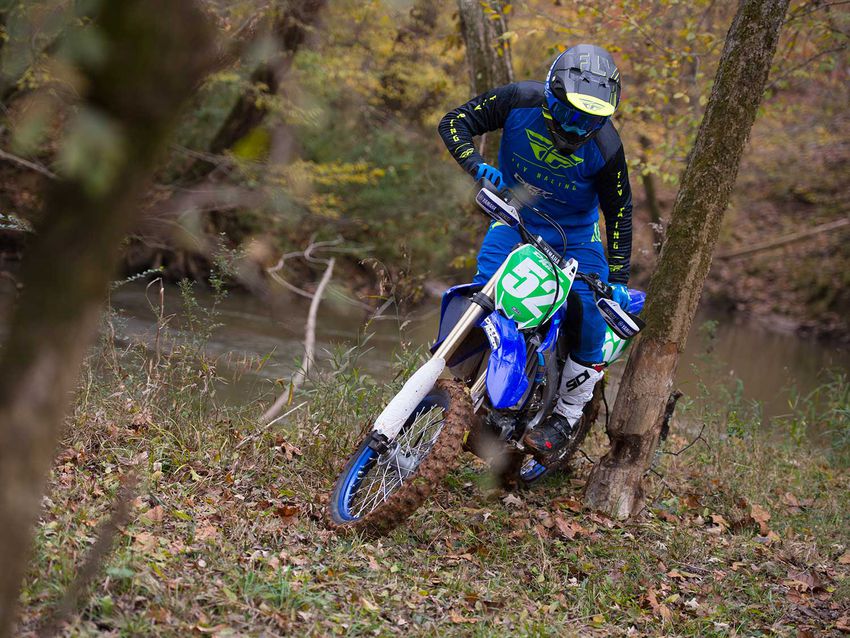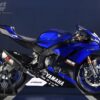ince 2014, the Yamaha YZ250F motocross bike has been a class leader. In 2015, Yamaha added a competition cross-country model, the YZ250FX, that remained relatively unchanged over the following five years. For 2020, however, Yamaha completely updated the YZ250FX to match the performance of its fraternal twin, the YZ250F. It may not look like it, but there are several significant factory-added features that make this bike a lethal GNCC and cross-country racing machine.
In the previous configuration, the YZ250FX was a little down on power compared to the YZ250F, so Yamaha made several changes to bring it up to a more powerful and competitive package. The 2020 YZ250FX shares almost all the same engine parts as the YZ250F and now features the same rear-mounted electric-start engine package. The main performance parts such as the cylinder head, camshafts, crankshaft, piston, and exhaust are the same as the YZ250F.
What is different is the ECU mapping. The YZ250FX now features the same adjustability as the YZ250F with its smartphone-based Power Tuner app. In stock form, it offers two different base maps with a two-position map switch mounted on the handlebar. With the light off, which is map 1, the engine is more responsive and quicker revving. With the light on, map 2, the engine has a smoother response and is slightly slower revving. With the Power Tuner app, you can make adjustments to both base maps on a 4×4 grid. Fuel adjustments are made with steps of -7 to +7 with a range of one step, which equals a 2-percent fuel change. Ignition adjustments are from -9 to +4 with a range of one step, which equals a one-degree change.
Related: 2020 Yamaha YZ125X Review First Ride
Excitedly, I can say the ’20 YZ250FX engine has stepped up to the level of power I was expecting. It’s noticeably improved over the previous generation model and has an almost identical feel as the motocross version. In comparison to the YZ250F, the YZ250FX comes on electrically smooth off the bottom and revs much further than most could ever demand in cross-country racing. With the new mapping, I might even prefer the amount of roll-on connectivity it has. The way I can roll the throttle on in second gear without using the clutch is perfect. The amount that it will rev out certainly helps bridge the gap between second and third gear too.
I spent some time working with the optional map, going from map 1 to map 2, and found that the difference in base settings is noticeable and can be beneficial depending on the soil conditions. I also spent some time using the Power Tuner app and found that tuning the bike could have even more benefits.
The gearbox on the YZ250FX is the same six-speed unit that came on the 2015 to 2019 model. First and second gears are slightly lower than the YZ250F, third gear is the same ratio, and fourth through sixth are increasingly taller than the YZ250F. If I could customize the gearbox, I would keep the low first gear and tall fifth and sixth gears and replace second, third, and fourth with the YZ250F ratios. I was not always a fan of this gearbox as I felt the gaps between second to third and third to fourth were too large for tighter GNCC-type racing. While the transmission in the 2020 model is the same, the added engine power has significantly improved the performance and makes these gaps much less noticeable.
To handle the additional power, Yamaha updated the clutch to a larger diameter. It now has a higher heat capacity and less fade. The clutch plates on the YZ250FX are off-road specific to help control clutch engagement and have a lighter lever pull than the YZ250F as well. We certainly put the clutch to the test in some extremely tight single-track (for GNCC racers it would be referred to as “bike only” trail) and experienced minimal fade. The clutch pull is surprisingly light, and if you were to increase the clutch spring pressure, you would still have a comfortable clutch pull.
Like the YZ250F, the YZ250FX is spec’d with a KYB Speed-Sensitive System (SSS) coil-spring fork and KYB shock. However, the off-road model is granted its own cross-country-specific suspension settings. Its internal valve shim stacks are designed to provide compliance and comfort on tighter trails. Additionally, it is designed to provide better absorption of sudden impacts.
The KYB SSS fork and KYB shock settings are noticeably improved, offering good bump absorption and hold-up under braking. The trademark planted Yamaha feeling provides you with confidence in those sections where you’re carrying lots of speed through the trees. I felt a little bit of blow-through on some of the bigger hits and G-outs, but that is to be expected of a cross-country suspension setting.
The YZ250FX chassis also features a plethora of changes. While many of these updates are the same as what the YZ250F received in 2019, they are worth noting. In comparison to the prior generation YZ250FX, the 2020 model has a new frame with increased rigidity and is 6mm narrower at the swingarm pivot. The frame’s vertical rigidity has been increased by 25 percent, horizontal rigidity by 9 percent, and torsional rigidity by 15 percent. The new engine mounting point brings the cylinder incline one degree more upright as well.
A significant and often overlooked item on a dirt bike’s chassis are the engine mounts. The YZ250FX has a reinforced main engine bracket, which can sometimes help with front to back rigidity and provide a more positive corner entry feeling. The new bodywork is designed to ease rider movement. The radiator shrouds have a new concave contour and are 18mm thinner across, which certainly makes the bike feel skinnier between your legs.
Naturally, the YZ250FX comes with a larger-capacity 2.2-gallon fuel tank (that is 0.6 gallon bigger than the YZ250F’s) but features the same compact design as the motocrosser, adding the fuel in areas that do not affect the overall width of the bodywork. Other nice off-road touches worth noting are the 18-inch rear wheel, kickstand, D.I.D MXV5 O-ring chain, composite skid plate, and the engine and low fuel indicators just in front of the handlebar.
The YZ250FX has a slightly lower seat height, which helps shorter riders maintain their balance in more technical and challenging areas. I think that taller riders would benefit from a tall seat foam. The bike has a noticeable pocket when sitting and the position of the pocket feels just a touch too far back. GYTR offers a taller seat that can help with cornering and when going from sitting to standing. I know most of you are thinking, “Yeah, sure, as if a taller seat is going to make that big of a difference.” If you have the opportunity to test one, give it a shot! Not for just one lap, but an entire day. Most riders switch the stock handlebar out for a different bend but rarely consider the seat.
I am very familiar with the YZ-F and YZ-FX line of bikes and am very excited to see the YZ250FX get updated. There were a few key items I was hoping would be changed, but was mainly looking to see if Yamaha was going to give it the same engine power as the motocross version being that the previous-generation YZ250FX had a noticeable step down in performance in comparison to the YZ250F. The chassis feels almost identical to the YZ250F, just with softer suspension. Overall, Yamaha did a great job with the updates they made to the 2020 YZ250FX. They filled in some of the small gaps the bike was missing to make it a better off-the-showroom-floor competition model.








































Reviews
There are no reviews yet.